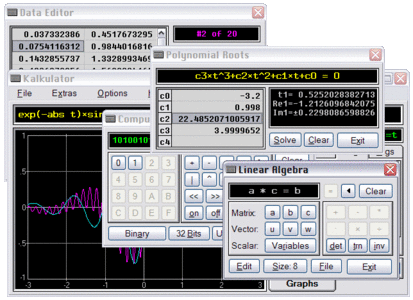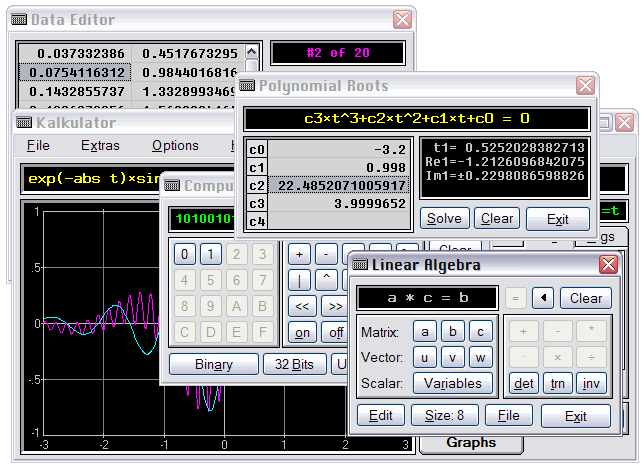Kalkulator 2.50 | PC | 825 KB
Kalkulator is a powerful yet simple to use calculator and numerical Swiss army knife for Windows (from 95 to Windows 8), with features making it especially suitable for scientific and engineering users, including students of these disciplines. It has graphing and custom function support making it one of the most handy and powerful calculators available.
Evaluating arithmetic expressions
Unlike most "normal" calculators with the display limited to one operand, Kalkulator allows you to enter the whole expression in a notation very much like the traditional, "blackboard" one, and only then computes its value. At any moment the expression can be reviewed, modified, and recomputed.
The user may switch between a number of expressions without reentering them.
If a syntax error is detected, the cursor will be placed right at the offending symbol and you will be able to fix the problem without retyping of the whole expression.
All computational errors are trapped: in the worst case you get a diagnostic message, not just an "E––" display.
A rich set of functions
Kalkulator has more than 100 functions, computed, where only possible, with 18 decimal digits of accuracy.
39 "standard" functions: logarithmic and exponential (base e, 10 and 2), trigonometric and inverse, hyperbolic and inverse, square, cube, and corresponding roots, plus some handy utility functions (fractional part, absolute value, etc.)
4 Euler (or related) functions: gamma, logarithmic gamma, beta, combinations. The factorial operator, !, is also provided.
44 statistical distribution functions for eight most common distributions; this includes not just distribution densities but also left, right, and central distribution integrals and functions inverse to these integrals, commonly used in statistics and never provided in calculators.
3 random number generators: uniform, Normal and Poisson.
3 conditional functions, selecting the second or third argument depending on the sign of the first argument.
3 mixed-unit entry functions: lb/oz, ft/in, hrs/min/sec.
12 user-defined functions (of up to four arguments).
Result formatting
Any computation result can be displayed in a choice of formats:
Fixed- and floating-point with a selectable number of digits (also a default format, based on the displayed value)
Whole part and fraction, e.g., "6 2/9"
Pounds, ounces and fraction, e.g., "4 7 9/16"
Feet, inches and fraction, similar to the above
Degrees, minutes and seconds of angle
Decimal degrees of angle (same for minutes and seconds)
Hours, minutes and seconds of time, e.g. "12:31:29"
Variables
Results of computations can be stored in variables (memory locations), denoted as A..Z. These can be later used in other expressions.
Unit conversion and physical constants
Any calculation result can be converted between different measurement units. Conversions for area, energy, force, length, mass, power, pressure, speed, temperature, time, and volume are provided.
The program allows you also to recall the values of a number of popular physical constants (or any other constants you may wish to define).
Both units and physical constants are user-configurable, being defined in separate text files.
Numerical operations
Kalkulator can take a function typed in as an expression and submit it to the following numerical operations:
Numerical integration over a given interval
Computing a derivative at a given point
Computing a sum within given argument limits and with a given step
Finding a zero point, i.e., solving an equation f(x)=0, within a given interval
Roots of polynomial equations
Kalkulator finds real and complex roots of polynomial equations with real coefficients (up to the fourth degree; up to the third in the non-registered version). Any arithmetic expressions can be entered as polynomial coefficients, and the roots (or their Re/Im parts) can be stored in any Kalkulator variable.
Function plots
Any function defined as an expression can be plotted within a given x-range.
A number of functions can be plotted within a single graph, either by adding a them one by one to the graph canvas or simultaneously.
The y-range can be entered manually or computed (and rounded) by the program. For multiple plots the joint range can be computed.
The algorithm makes necessary adjustments for the local line curvature and properly handles discontinouities.
There is an option to include the coordinate grid.
Mouse coordinates can be read out and saved into variables.
Graphs can be copied to Windows clipboard for use with other programs.
Computer math calculator
A separate panel is used as an RPN computer math calculator with the following basic features:
16 arithmetic operators, including shift and rotation, bit set/reset, AND, OR, exclusive OR, etc.
8-, 16-, and 32-bit word length
Binary, octal, hexadecimal, and decimal data format and input
Unsigned and signed (two's complement) arithmetic modes
Stack maniulation, ten memory registers
Statistical operations
Kalkulator has a data buffer to store one- or two-dimensional data points (X or XY). Simple statistical and graphic operations can be performed on the data:
Computing the population parameters: mean, variance, standard deviation, minimum and maximum values, covariance (if applicable)
Drawing a data histogram of X points
Drawing a scatter plot of XY points, computing polynomial regression coefficients and adding the regression line to the plot
Computing the values of test statistics ("goodness of fit"):
For a set of XY points and a given x-y function: sum of squared or absolute deviations
For a sample of X points and a given distribution density function: chi-square or likelihood value
The X and/or Y values can be, in a wholesale fashion, computed using any formula (which may refer to other values in the buffer).
The data buffer values and computed parameters can be used in any Kalkulator expressions.
Distribution or regression fit
Kalkulator fits your data with an arbitrary regression or distribution function with up to nine free parameters.
For a set of XY points it finds the values of parameters p1..pn for which the regression function y = f(x|p1..pn) fits the points best in terms of minimum squared or absolute deviations.
For a population of X points it finds the combination of p1..pn for which the distribution density f(x|p1..pn) fits the population distribution best in terms of minimum chi-square or maximum likelihood. The shape of f(x) does not have to be chosen from a predefined set; any analytical formula will be accepted. Now, if you had any doubts who's the king of the hill…
Linear algebra operations
Kalkulator performs arithmetic operations on vectors and matrices. These operations include:
Addition and subtraction of vectors or matrices
Matrix, vector, and scalar multiplication (any combination of operands)
Dot product, cross product
Matrix transposition
Matrix inversion
Solving systems of simultaneous linear equations
A spreadsheet-like editor for matrices and vectors is provided.
All elements of a matrix (or a vector) can be defined with a single expression using the index value(s) as parameter(s).
Systems of nonlinear equations
Kalkulator also solves (or at least attempts to solve) systems of up to nine nonlinear equations, using the Newton-Raphson method, starting from a user-supplied initial guess.
Differential equations
Kalkulator solves systems of up to nine ordinary differential equations (ODE) of the first order. Most problems involving higher-order derivatives can be easily converted into first-order ones and then solved using Kalkulator. The popular Runge-Kutte technique is used.
Function extremum search
Given a function of up to nine arguments and an initial guesstimate, Kalkulator uses the downhill simplex method to search for the function minimum or maximum.
Save and restore
Upon exit from the program, the complete status of all operations and settings is saved, to be re-read from disk next time Kalkulator runs. The program will continue as if it was never exited from.
Ease of use
The user interface has been carefully designed: the more advanced features do not stand in the way of users with simpler needs (here, of course, you will be the judge). There is also a comprehensive Windows Help file attached
Homepage:
http://www.wrotniak.net/works/kalkulator/



